Meat Cooking Techniques You Should Be Using On Your Vegetables
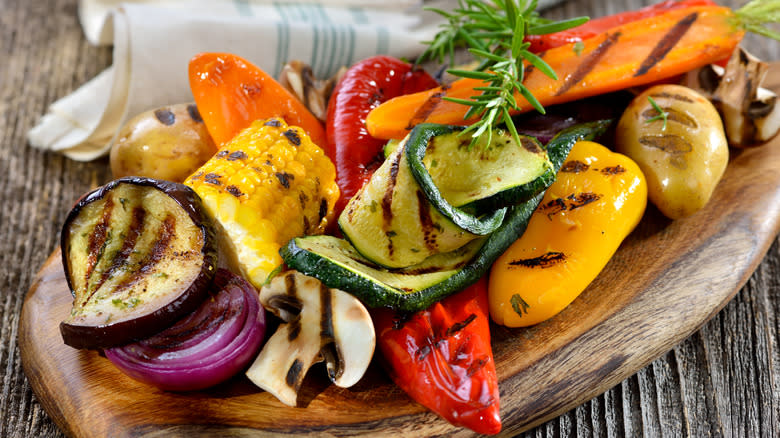
Eating healthy doesn't have to mean cooking plain, mushy vegetables. You might have grown up begrudgingly eating vegetables that were steamed or boiled to death, hating them for their lack of discernible flavor. But maybe it's time to rethink how we treat vegetables. With so much variety in size, texture, taste, and color, vegetables deserve a little more respect in the kitchen. In fact, with the right cooking methods, they may even outshine the meat.
If you're curious about plant-based cooking or simply want to consume less meat, there are many ways to make vegetables more interesting. The first step is to stop treating them like an afterthought. Instead, reimagine them as the main event. Just as there are countless ways to prepare chicken, beef, or fish, different cooking methods can bring out bold, delicate, and sometimes unexpected flavors in vegetables. You can even use cooking methods that are normally reserved for meat. The fun lies in experimentation, so test out these meat-cooking techniques for yourself and take your vegetables to the next level. You may even learn a few new tricks along the way. In no time, you'll be transforming boring, bland veggies into the star of the show.
Read more: Mistakes You're Making With Your Corn On The Cob
Using High Heat
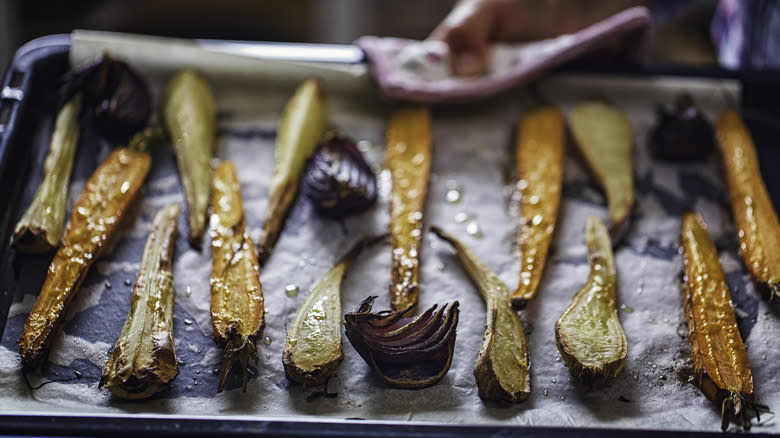
Most people are already familiar with roasting vegetables. Drizzle some oil, stick them in a pan, and pull them out when they're cooked to your liking. But what you might not realize is that you can crank up the heat. Like meat, vegetables respond well to high temperatures. The heat causes the sugars inside the veggies to caramelize, enhancing their natural sweetness. Texture-wise, you'll get veggies that are perfectly crispy on the outside and soft on the inside.
Heat the oven to any temperature between 425 and 450 degrees Fahrenheit, preheating your pans as you wait. Prep the veggies with olive oil, salt, and your favorite herbs or spices. Make sure the vegetables are spread out evenly on the pan, as overcrowded veggies may steam instead of roast. Place them in the oven and wait. When you see browning and beautifully charred edges, you'll know they're ready to enjoy. High-heat roasting brings out incredible flavors in a wide range of vegetables, making this simple method anything but boring. And while you're here, kick it up another notch with these game-changing roasted veggie secrets you'll wish you already knew.
Marinating
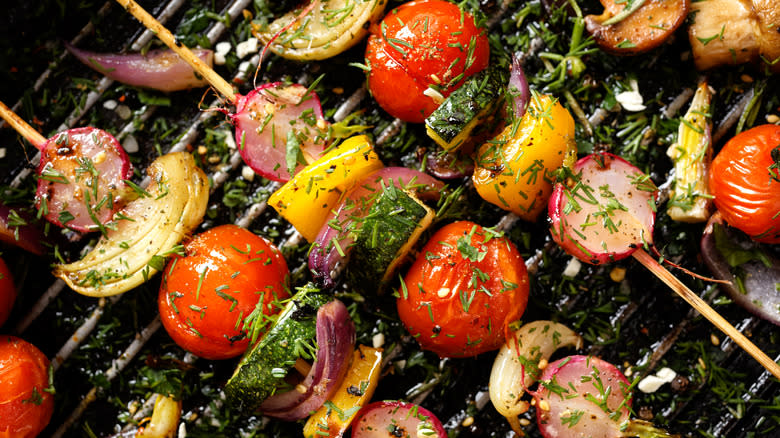
Marinating, a technique often used with meat, can also significantly benefit vegetables. A long soak in a bag of spices and oil infuses them with flavor inside and out. Then, whether you stick them on the grill, in a pan, or in the oven, your veggies will be bursting with complexity and depth. When deciding what to put in your marinade, it all depends on your flavor preferences. Oil, salt, herbs, and spices make up the base of most marinades. You can also add vinegar, soy sauce, lemon juice, aromatics like garlic and onions, or anything else really. (Check out this great tip for grilling veggies from Max the Meat Guy, a BBQ-enthusiast digital creator.)
Simply prep your veggies and toss them in a plastic bag with your chosen ingredients. Let them marinate in the fridge for four to six hours, or leave them overnight to fully absorb all the flavors in the bag. Note that vegetables like eggplant and mushrooms contain a lot of water, so you first need to apply salt to draw out some of the moisture. After patting them dry, you can marinate as normal. Practically any vegetable works in a marinade, so it's worth trying out with whatever you have on hand, as long as you plan slightly ahead of time.
Applying Dry Rubs
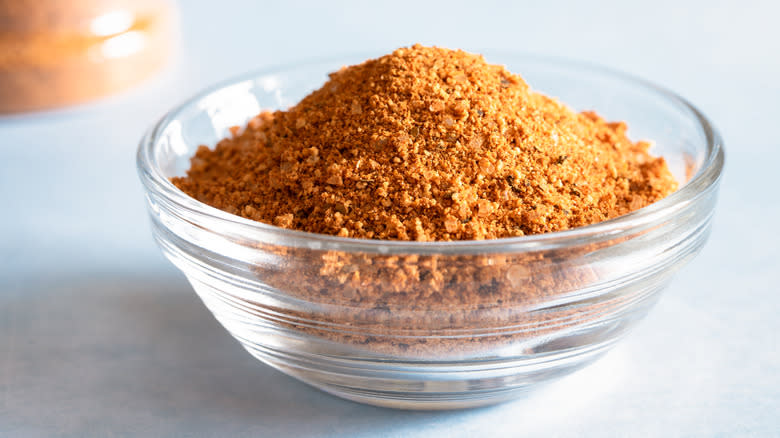
Dry rubs are a great way to elevate your vegetables with minimal effort. Unlike marinades, which require long soaking times, dry rubs season the surface of your vegetables quickly. To make the rub, assemble and combine your choice of spices and seasonings. Or, use whatever pre-made mix you already have in your cupboard. Lightly oil your vegetables so the dry rub sticks, then toss them in your spices. You want a thick, even layer to stick to the veggies, as this will create a tasty crust when cooking. From there, cook your vegetables however you wish. Roasting, grilling, and pan-frying are all excellent options.
The sky's the limit when it comes to spice and seasoning combinations. If you're at a loss, take inspiration from celebrity chef Bobby Flay. He uses paprika, black pepper, coriander, cumin, dried thyme, dried mustard, and salt in his flavorful all-purpose dry rub. But you can use any spices you find in your pantry. For example, you likely already have everything to make a delectable homemade taco seasoning rub. Just mix together paprika, onion powder, chili powder, cumin, oregano, and salt.
Grilling
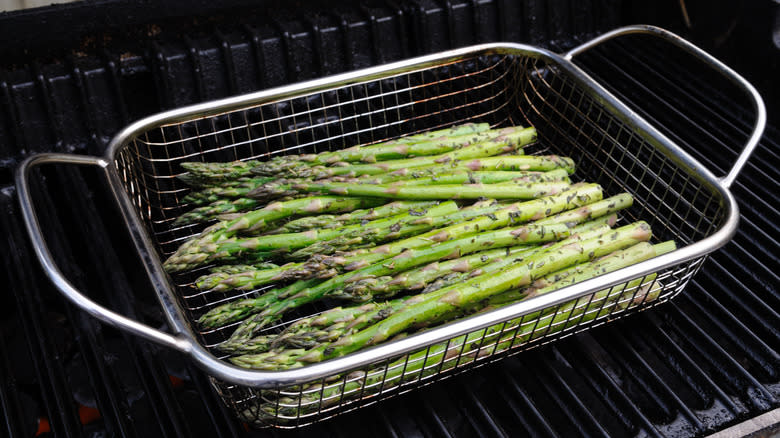
Grilling isn't just about the meat 一 vegetables of all kinds can be transformed on the grill. The heat intensifies their natural sweetness, making each bite irresistibly succulent and flavorful. Charred by the heat, vegetables take on a smoky depth, making you forget all about the meat. Although tasty on their own, grilled veggies are also great in pasta (see: this savory grilled summer vegetable pasta salad), sandwiches, and on top of salads.
When cooking vegetables directly on the grill, choose larger pieces that won't fall through the grates. Halved bell peppers, squash, onions, and (of course) corn on the cob are delicious choices. If you want to cook smaller vegetables, throw them into a grill-safe basket. If you don't have a basket, you can use aluminum foil instead. Cover the vegetables in foil and seal the sides, leaving a small hole for the steam. Then, place the foil pack on the grill.
Another method is to make vegetable kebabs. Just keep in mind that different veggies take longer to cook than others. Make sure to place vegetables with similar cooking times on the same skewers, or just use one type per stick. With any grill method, remember to season your veggies first.
Smoking
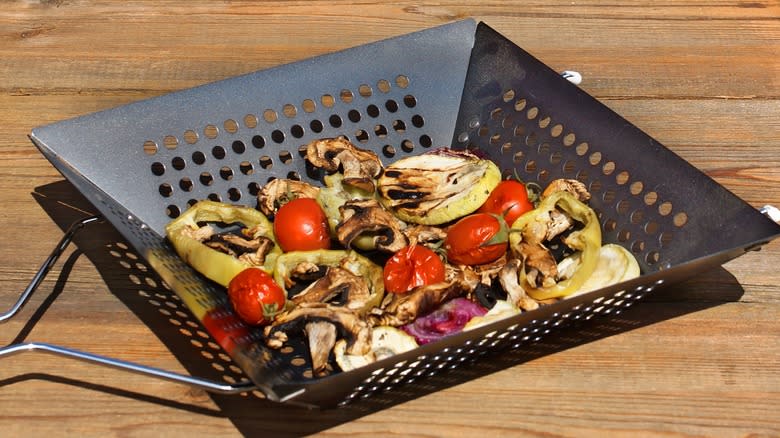
Smoked vegetables are sure to win over even the most die-hard meat lover. That smoky, woodsy taste that many associate with meat also perfectly complements the sweetness in vegetables. Cut all your veggies so they are roughly the same size, then season them with oil and spices. If you own a smoker, your job is easy. Pop your veggies into the appliance, sit back, and wait for the magic to happen.
If you're smoking vegetables using a grill, the key is to cook them over a long period at a low temperature. With most types of grills, you'll need to add water and wood chips or chunks. Choosing a type of wood depends on your desired flavor profile. For example, mesquite is the strongest-tasting of the woods, hickory is on the sweet side, and fruitwoods can carry hints of apple, cherry, or orange, depending on the variety. Carrots, potatoes, onions, mushrooms, and corn are especially delicious smoked, but you can smoke any vegetable that you would typically grill.
Brining
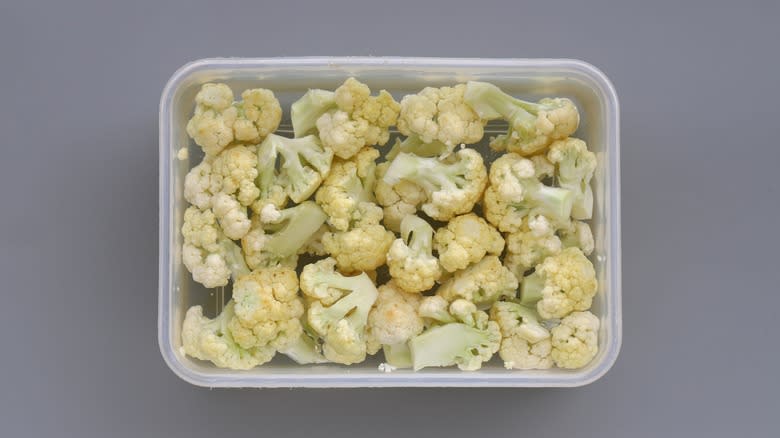
When we say to brine your vegetables, we don't mean pickle them. Think of brining in terms of how you might prepare pork, chicken, or turkey around the holidays. Brining is a technique that tenderizes and flavors meat while also helping it to retain moisture. Brining vegetables works similarly. The salt helps bring out the veggies' best flavors, making them anything but bland when it's time to grill or fry.
One common method is to soak them in a salt bath. This works best with sturdier varieties like cauliflower, broccoli, corn, artichokes, or root vegetables. Don't worry, the final dish won't be overly salty 一 the salt enhances their natural flavors without overpowering them. Prepare a mixture of 1% salt water and soak the vegetables overnight. For a shorter soak time, increase the amount of salt. Paul Adams from America's Test Kitchen recommends leaving vegetables in a 10% salt brine for an hour (via Wired). To create a 10% brine, add a measurement of salt equal to 10% of the combined weight of your vegetables and water.
Another method is to make a dry brine. Simply coat your veggies with a mixture of salt and spices and let them sit for a few hours. Dry brining, unlike applying a dry rub, relies on an extended length of time for the vegetables to absorb the flavors and effects of the salt mixture.
Pan-searing
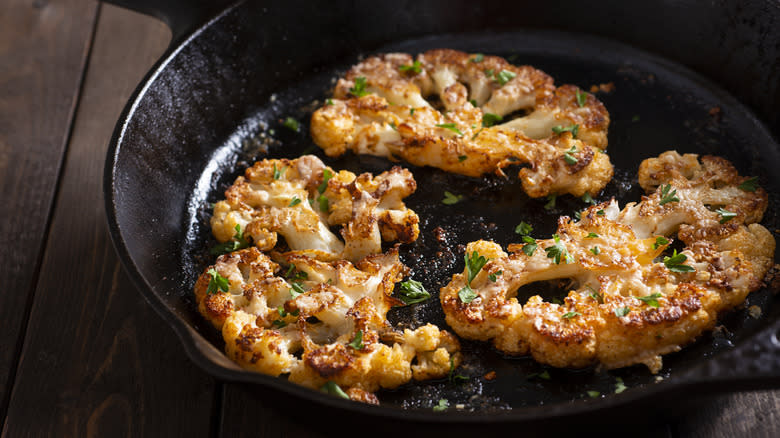
A good sear works wonders on a cut of meat, creating a tasty outer crust while keeping the inside juicy. This same technique can be applied to vegetables. The high heat causes the veggies to develop browning, resulting in a layer of crispy, caramelized deliciousness. To begin, season your veggies and heat up a pan or skillet (cast iron is ideal) on high, adding enough oil to coat the pan. Lower the heat to medium-high and add the vegetables, taking care not to overcrowd the pan. It's crucial that you leave the vegetables alone for several minutes so they can properly sear. Once they're browned to your liking, flip them and cook the other side.
After searing, you may then opt to roast the vegetables in the oven until they're tender. This step is a must when cooking thicker pieces or whole heads of cauliflower, for instance. Once cooked, serve the veggies with a sauce or garnish with fresh herbs, lemon, and a drizzle of olive oil. This easy technique works with any vegetable, transforming them into exquisite meat-free mains or flavorful side dishes.
Braising
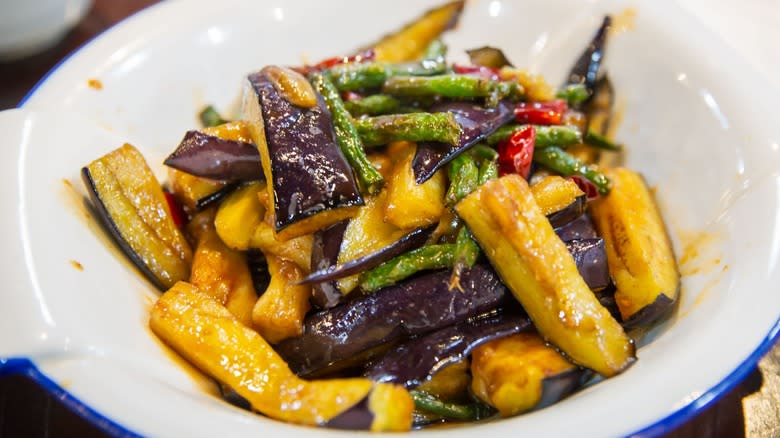
Braising is a two-part process. It typically starts with a sear to lock in flavor, then finishes with a low and slow simmer in liquid. While often used with meat, this technique can also bring out delicate notes and textures in vegetables. There are no rules against which veggies you can braise, but several good options include eggplant, green beans, onions, artichokes, cauliflower, and carrots.
First, sear the veggies in a deep pan or Dutch oven at medium-high heat. Once browned, remove the veggies and set them aside. In the same pan, add aromatics like garlic or onions and cook them down with your choice of herbs. For the simmering liquid, create a mix of stock, wine, paste, and seasonings, then add it to the pan. Gently reintroduce your seared veggies and cover them with a lid, then simmer on low heat. You can either place the pan in the oven or keep it on the stovetop. While meat can take several hours to cook, vegetables usually need a lot less time. The end result is irresistibly tender yet flavorful.
Butter Basting
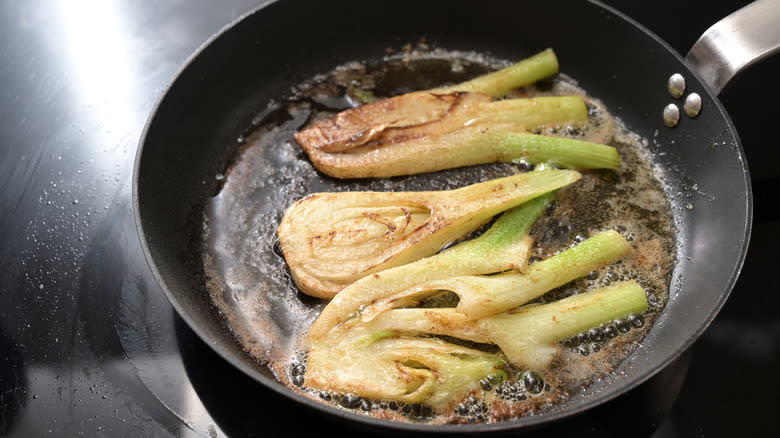
Butter basting is the process of adding butter to meat while it cooks, enriching the meat with flavor and locking in moisture. It's no secret that everything is better with butter, and vegetables are no exception. Butter basting might just be the key to converting even the most picky veggie-doubter.
To begin, sear your veggies in a pan at high heat. When they're browned or charred to your liking, turn down the heat and add in unsalted butter. To translate this technique to plant-based cooking, swap out the butter for some coconut oil. You can also toss in some aromatics like garlic, onions, or herbs 一 they'll infuse the butter with flavor and add another layer of deliciousness to your veggies. As the butter browns, tilt the pan and scoop up the melted liquid with a spoon, spreading it back on top of the vegetables. Flip the veggies constantly, and remove them from the pan when they're tender.
Try out this method with any vegetable that you'd normally sear. For any particularly thick or fibrous veggie, try scoring its surface with a knife first. This allows the butter mixture to better absorb into the vegetable.
Sous Vide
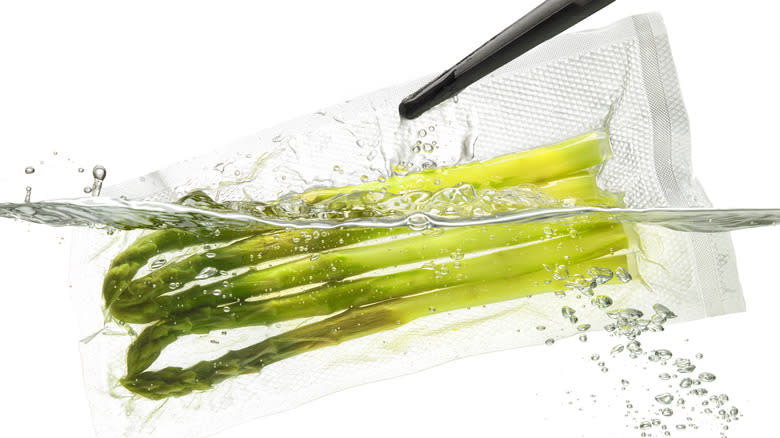
Sous vide takes the guesswork out of cooking meat, guaranteeing an even degree of doneness. This same level of control translates beautifully to vegetables, unlocking delicious, vibrant results. For this technique, you'll need a sous vide cooker (also called a water circulator) and sealable plastic bags. Cut the vegetables into uniform pieces, season them, and place them in the plastic bag along with any other ingredients. Oil, fat, herbs, garlic, sugar, salt, and spices are just some of the ingredients that can elevate your veggies.
Add enough water to cover your vegetables and set the circulator to the correct temperature. For most vegetables, this will be between 183 and 194 degrees Fahrenheit. Then, place the bag in the water, weighing it down so it's fully immersed. Cook for 30 minutes to three hours, depending on the veggie. Make sure not to overcook them, or you'll end up with a mushy mess.
If you have the gear, sous vide is a simple and versatile cooking method. You can eat the veggies straight out of the bag, or you're welcome to finish them with a sear. You can even make sous vide mashed potatoes 一 just place peeled and cut potatoes, cream, milk, butter, garlic, rosemary, and salt into a bag and submerge.
Poaching
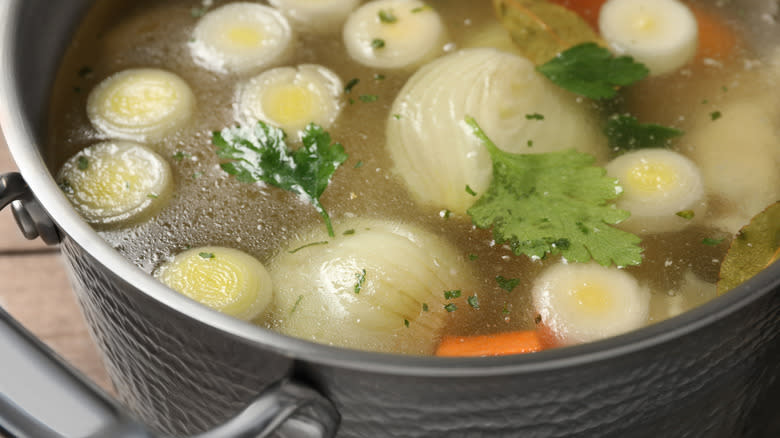
Poaching is usually reserved for chicken, fish, or eggs, but it can also bring out subtle flavors in veggies. Unlike boiling, this technique involves gently cooking vegetables at low heat using flavored water or broth. To try it out for yourself, chop up your veggies and decide on a poaching liquid. One simple option is to mix water, white wine, olive oil, salt, and aromatics like bay leaves, garlic, and onions. First, cook off the wine on its own for a few minutes, then add in the rest of the poaching ingredients, cooking everything at low heat for at least 10 minutes. Then, add in the vegetables you want to poach, making sure that there's enough liquid to just cover them. Cook until they're tender but still somewhat crunchy.
The possibilities are endless for poaching liquids' ingredients and flavor pairings. Instead of wine and water, you can use vegetable stock, spiced liquor, or even fruit juice with the right seasonings. Serve your veggies with a little bit of the poaching liquid for extra flavor, or enjoy with pasta or rice. You can save the leftover liquid to use as stock or cook it down to a sauce.
Confit
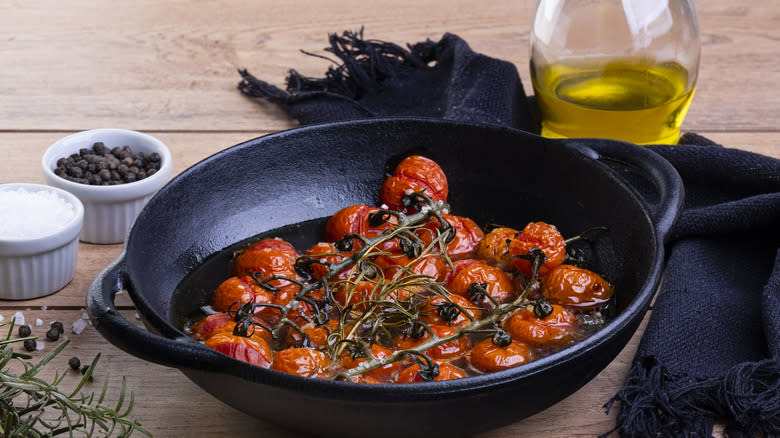
Confit is a great way to preserve the shelf life of food while building depth of flavor and a velvety texture. The French technique traditionally involves cooking meat in its own fat. However, it's possible to cook vegetables in the same way, using olive oil in place of animal fat. The result is tasty and convenient 一 you can stick your confit veggies in a jar and use them to spice up dishes for weeks to come.
To make confit veggies of your own, choose heartier varieties such as potatoes, carrots, fennel, or bell peppers. Tomatoes, garlic, leeks, and mushrooms are also popular options. After peeling away any tough skin, chop the vegetables into even pieces and season them with salt, spices, or herbs. Preheat the oven to a low temperature (somewhere between 200 and 275 degrees Fahrenheit will work). Toss the veggies into an oven-safe dish or pan and pour in the olive oil, adding enough to submerge them. You can also use vegetable or sunflower oil (check out this guide to the different types and uses of cooking oils). Place the pan in the oven and leave it in for one to three hours, depending on the size of the veggies. Once they're nice and tender, let them cool before using or storing.
Add your confit veggies to pasta and salads or use them as special pizza toppings. They make the perfect condiment for any dish or snack.
Deglazing
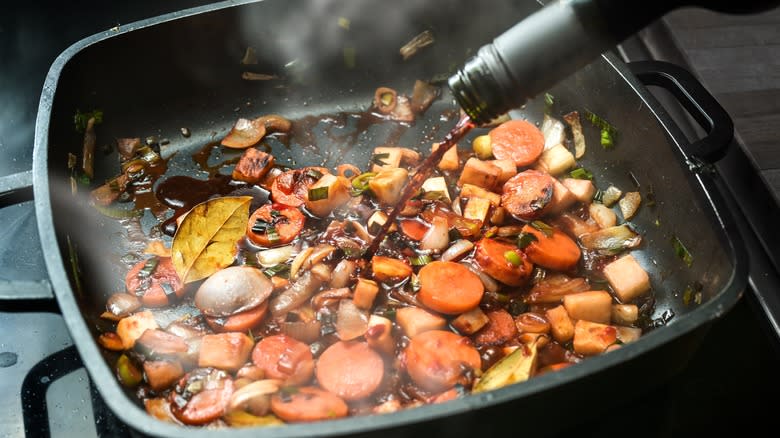
Deglazing is a technique typically used after pan-searing meat. It serves two purposes: cleaning the pan and creating a flavorful sauce. After removing the meat, liquid is added to the pan, infusing with all the leftover drippings and food bits to build a savory sauce.
Thankfully, deglazing isn't just for meat eaters. This tasty trick works wonders with pan-cooked vegetables of any shape and size. While you can follow the same steps and add liquid to an empty pan, you can also deglaze while your veggies are still cooking.
To try out this technique, first sauté or sear the vegetables per your recipe's instructions, making sure not to burn anything. With the veggies still in the pan, adjust the heat to medium. Then, pour in a cold liquid such as wine, brandy, vodka, stock, juice, or water. Your choice will depend on the flavors you want to develop in your dish. Bring it all to a boil and continuously scrape the bottom of the pan with a wooden spoon or spatula (a straight edge is best). Do this until the liquid has reduced to half its original volume. You can then turn off the heat and enjoy, or add any other ingredients to finish off your sauce.
Read the original article on Mashed

